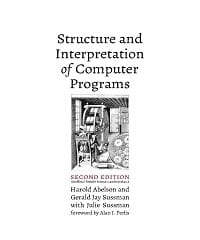 Free Download Structure and Interpretation of Computer Programs 2nd Edition Book in PDF written by Harold Abelson and Gerald Jay Sussman with Julie Sussman & Published by The MIT Press Cambridge, Massachusetts London, England.
Free Download Structure and Interpretation of Computer Programs 2nd Edition Book in PDF written by Harold Abelson and Gerald Jay Sussman with Julie Sussman & Published by The MIT Press Cambridge, Massachusetts London, England.
According to the Authors, ” Educators, Generals, Dieticians, psychologists, and parents program. Armies, students, and some societies are programmed. An assault on large problems employs a succession of programs, most of which spring into existence en route. These programs are rife with issues that appear to be particular to the problem at hand. To appreciate programming as an intellectual activity in its own right you must turn to computer programming; you must read and write computer programs many of them. It doesn’t matter much what the programs are about or what applications they serve. What does matter is how well they perform and how smoothly they fit with other programs in the creation of still greater programs. The programmer must seek both perfection of part and adequacy of collection. In this book the use of “program” is focused on the creation, execution, and study of programs written in a dialect of Lisp for execution on a digital computer. Using Lisp we restrict or limit not what we may program, but only the notation for our program descriptions.
Our traffic with the subject matter of this book involves us with three foci of phenomena: the human mind, collections of computer programs, and the computer. Every computer program is a model, hatched in the mind, of a real or mental process. These processes, arising from human experience and thought, are huge in number, intricate in detail, and at any time only partially understood. They are modeled to our permanent satisfaction rarely by our computer programs. Thus even though our programs are carefully handcrafted discrete collections of symbols, mosaics of interlocking functions, they continually evolve: we change them as our perception of the model deepens, enlarges, generalizes until the model ultimately attains a metastable place within still another model with which we struggle.
Among the programs we write, some (but never enough) perform a precise mathematical function such as sorting or finding the maximum of a sequence of numbers, determining primality, or finding the square root. We call such programs algorithms, and a great deal is known of their optimal behavior, particularly with respect to the two important parameters of execution time and data storage requirements. A programmer should acquire good algorithms and idioms. Even though some programs resist precise specifications, it is the responsibility of the programmer to estimate, and always to aempt to improve, their performance.
Table of Contents
- Building Abstractions with Procedures
- Building Abstractions with Data
- Modularity, Objects, and State
- Metalinguistic Abstraction
- Computing with Register Machines
Free Download Structure and Interpretation of Computer Programs 2nd Edition Book in PDF written by Harold Abelson and Gerald Jay Sussman with Julie Sussman from following download links.
File Size: 7.07 MB Pages: 883 Please Read Disclaimer
Don’t forget to drop a comment below after downloading this book.
Note: If download links are not working, kindly drop a comment below, so we’ll update the download link for you
Happy downloading!
You may also like to download Computer Systems A Programmer’s Perspective in PDF